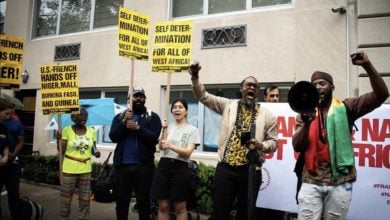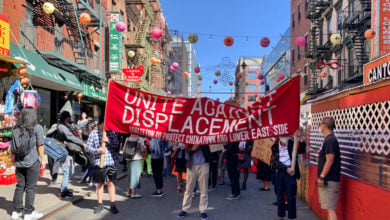Tet, as it is simply called by many who fought in the Vietnam war, is a word that has become synonymous with breaking the myth of U.S. military invincibility.
 Gen. Vo Nguyen Giap (in black), |
Catching U.S. military intelligence completely off guard, the offensive started on Jan. 30, 1968—the day before the Tet Lunar New Year was to begin. Over 80,000 PAVN soldiers from the North had infiltrated the occupied South and launched simultaneous attacks in more than 100 towns and cities, including the puppet South Vietnamese government’s capital, Saigon.
While the U.S. military was focusing on a probable attack on their base at Khe Sanh, five battalions of liberation soldiers slipped into Saigon in small groups of twos and threes. Their movement went undetected by security police, informers and U.S. intelligence.
As the population prepared for the lunar new year, weapons were brought into the cities and stored in people’s homes. They were carefully smuggled, hidden in flower carts, coffins with fake bottoms, in the bottoms of trucks filled with vegetable and rice.
Provincial capitals and U.S. bases were hit marking a shift in the war from the jungles and rural areas into the cities. Military intelligence recognized popular support in the villages for the NLF and PAVN, but completely missed the organized guerilla networks that existed in Saigon and other cities.
In most cases the NLF and PAVN were forced to pull back in a few days into the offensive except in the imperial capital of Hue and Khe Sanh, where sustained fighting continued for two more months.
General Vo Nguyen Giap, the architect of the Tet offensive, oriented the liberation armies by explaining that they were about to inaugurate the greatest battle in Vietnam’s long history against invasions. “Crack the sky, shake the Earth” became the slogan for the intense, well-coordinated campaign that shook the resolve of Washington and the Pentagon generals.
Thousands of Vietnamese soldiers and hundreds of U.S. troops were killed during Tet, but it created the perception that the Vietnamese, led by the communist North, could strike anywhere at anytime. That shift helped switch the momentum against Washington and its puppet President Nguyen Van Thieu.
Armed resistance tips the scale
The impact of Tet was such that it forced President Lyndon Johnson to begin de-escalating the war and start the process of turning the fighting over to the Army of the Republic of Vietnam (ARVN). The setback so demoralized Johnson that it became a major factor in his decision not to run for re-election in 1968.
It should be remembered that it was a Democrat—John F. Kennedy—who established the U.S. military presence in Vietnam in the early 60s, and that another Democrat—Johnson—expanded the occupation to its height of 500,000 troops by 1968.
How could the largest most technologically advanced military in the world lose to an underdeveloped, primarily agrarian country as Vietnam? During the Vietnam War, the imperialists looked at the North Vietnamese capabilities and lack of military might. Washington ignored the Vietnamese people’s intentions, determination and leadership. As is the case in Iraq today, the imperialist mindset is that military superiority is the defining factor in all wars.
History has proven that orientation to be thoroughly misguided.
The PAVN was a disciplined army based on a communist society fighting for their homeland. The NLF cells in the cities were organized on communist models with broad popular support. The PAVN were viewed as liberators by the people and the NLF was part of the organic anti-imperialist movement in the South.
Even though the United States dropped more bombs on Vietnam than were dropped during all of World War II, this only increased resistance and insurgency.
Up until Tet, the U.S. military tried to portray itself as winning the war through daily briefings of enemy body counts, much like a sporting event. The general of all U.S. forces in Vietnam, William Westmoreland, had come up with a simplistic “kill ratio” formula that subtracted the number of NLF and PAVN soldiers killed from their ability to refill previous unit strengths.
Tet shattered all of the smoke and mirrors. Support for the war plummeted and anti-war demonstrations in the United States grew larger. That turning point is a lesson for today’s anti-war movement, as it reveals the intrinsic connection between resistance abroad and resistance at home.
Over 57,000 U.S. soldiers died and 300,000 were wounded during the Vietnam War. The Vietnamese sacrificed between 5 and 8 million lives. In the end, no amount of U.S. military power could subjugate the Vietnamese once rejection of colonial domination had become an integral part of their consciousness.




